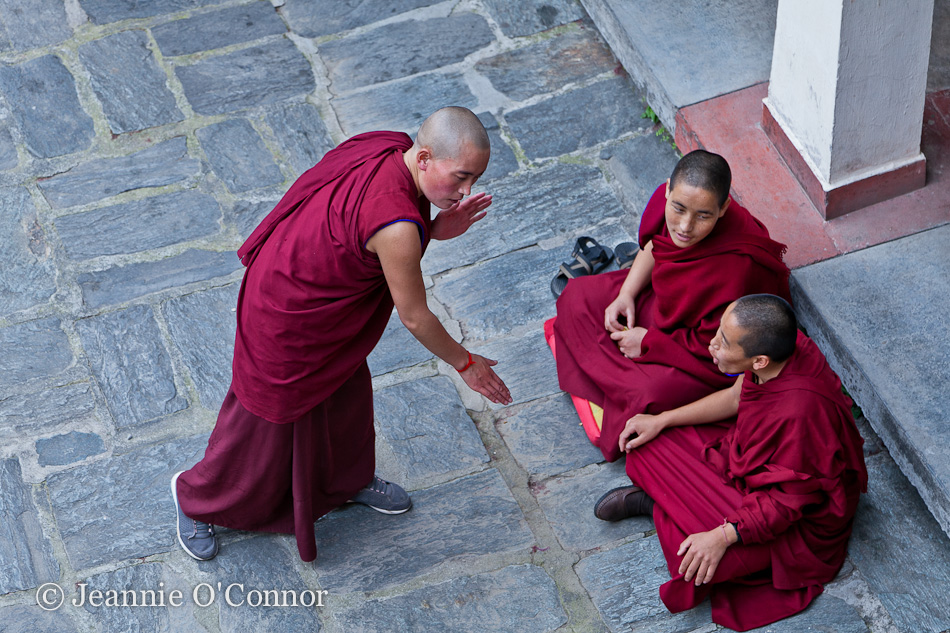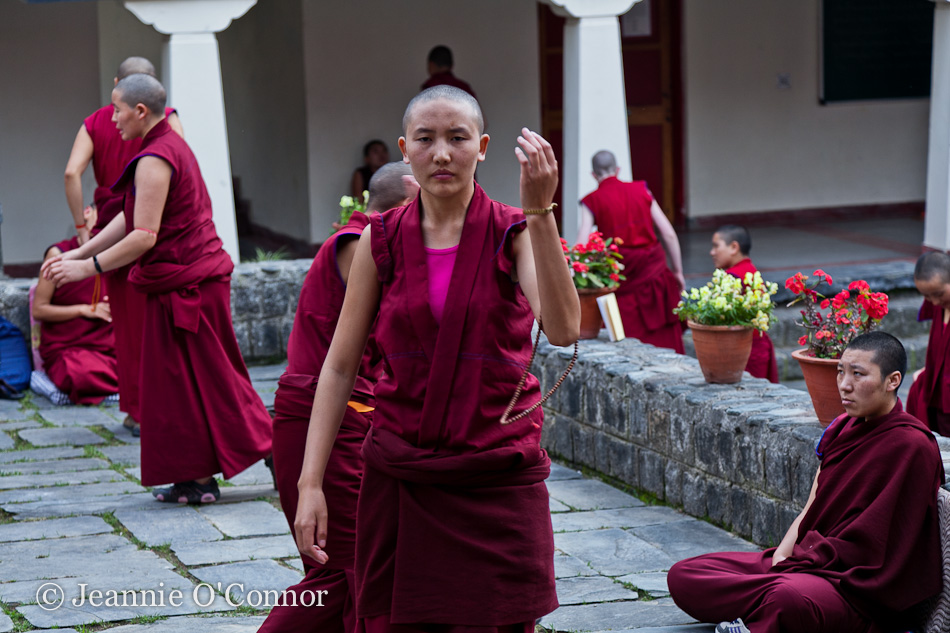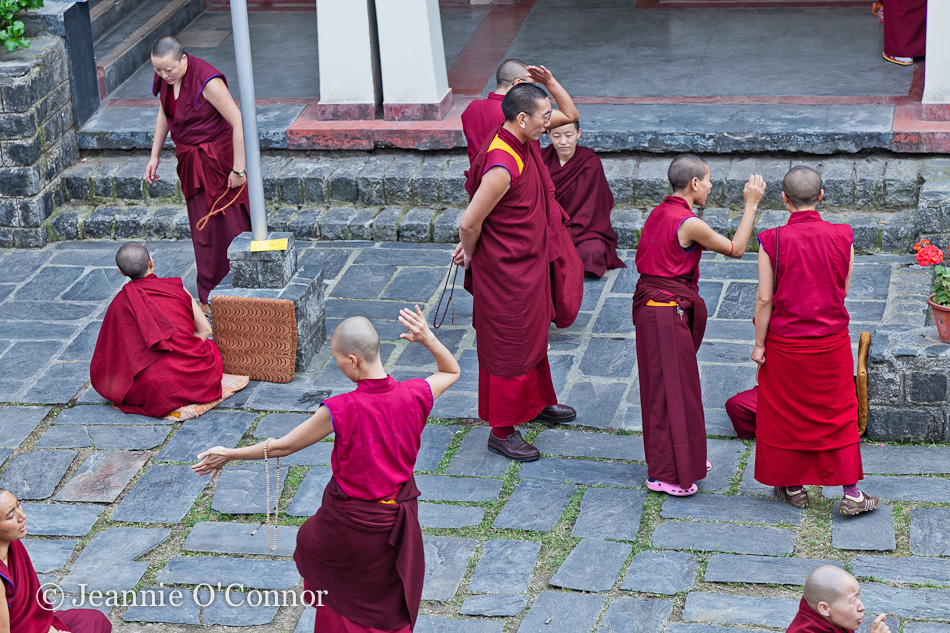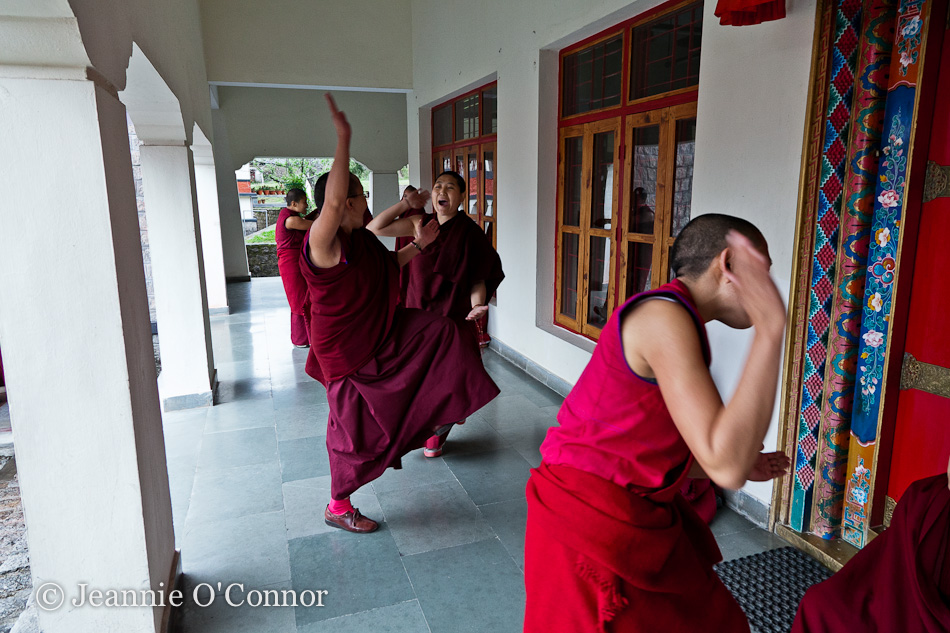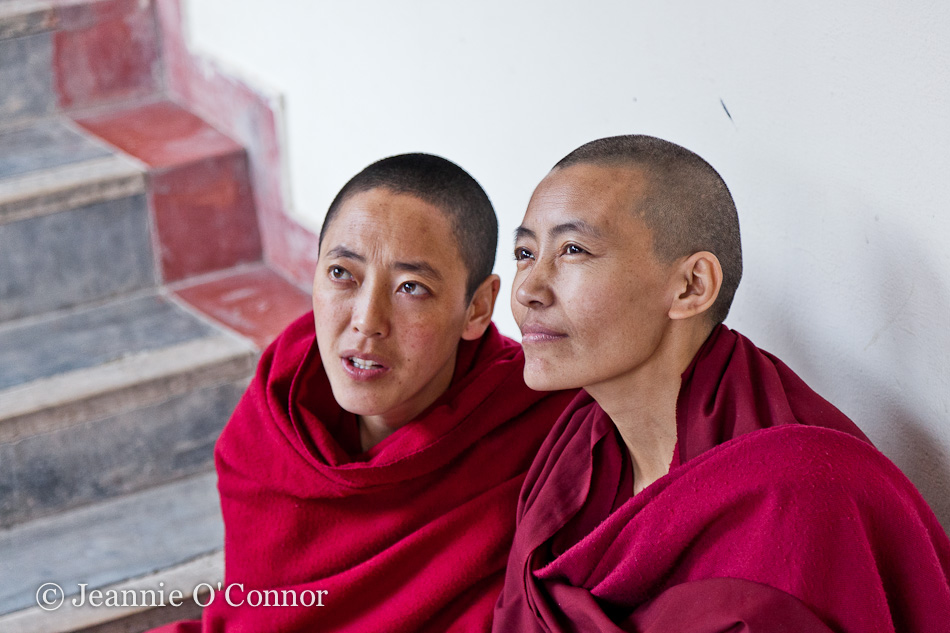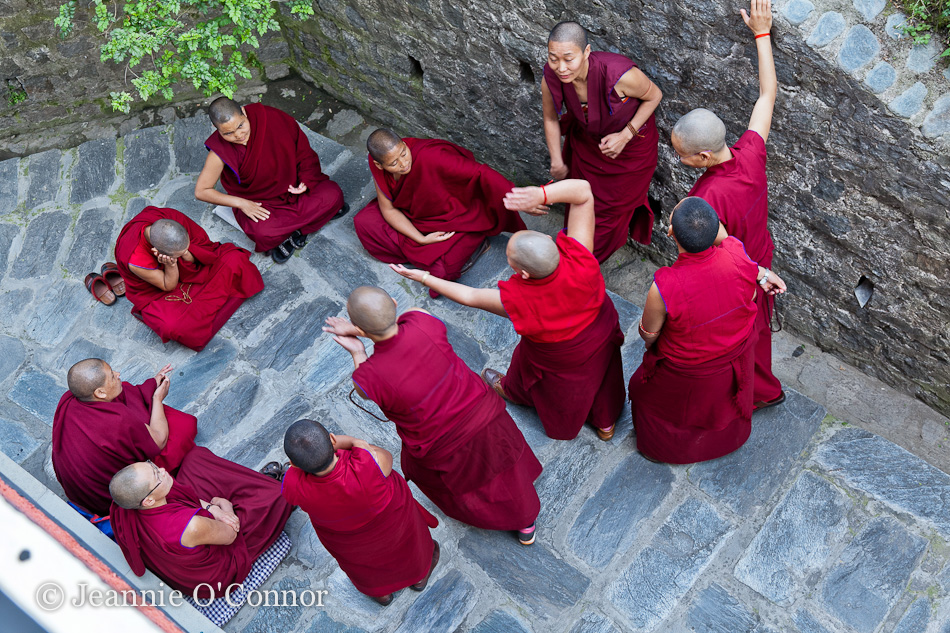In the sitting room at Kashmir Cottage, situated between the main town of Dharamsala and the area that is the seat of the exiled Tibetan government in India, I shared a pot of ginger tea with Rinchen Khando Choegyal, founder and director of the Tibetan Nuns Project and wife of the younger brother of His Holiness the Dalai Lama. I enjoyed the resonant cadence of her voice as she described the history of the project and the work of women, lay and monastic, in keeping alive the teachings of the Buddha and the richness of Tibetan culture amid the hardships of exile.
Rinchen Khando was born in eastern Tibet; her parents, from a farming and business background, were, as she put it, “well-to-do, but very devout and simple people.” At the end of 1958, her family came to India for a pilgrimage to Bodh Gaya and Varanasi. The plan was to leave the young Rinchen in India to attend a boarding school run by Catholic nuns. But before her parents returned home, the Chinese invaded Tibet. Since then, her family has lived in India. “Because we were already in India in 1959,” said Rinchen Khando, “we were saved.” They’d left behind almost everything they had.
In 1987, together with other activist women in the exile community, Rinchen Khando established the Tibetan Nuns Project (TNP). The project is committed to education, empowerment and improved status for ordained Tibetan women. It now supports over 700 Tibetan nuns living in North India.
According to Elizabeth Napper, Tibetan scholar and codirector of the TNP since 1991, “Opening up education to the women, particularly in conjunction with training in debate, has been transformative for the nuns. Not only have they been given access to the full intellectual richness of their Buddhist tradition but also, through debate, they have been trained to actively engage with it in a way that gives them confidence in their knowledge. Their body language changes from the traditional meekness of nuns to that of women who occupy space with confidence in their right to do so.”
In a trip to Dharamsala in January 2013, I visited two nunneries supported by the TNP. At Shugsep Nunnery, which follows the Nyingma tradition, many of the nuns are from the original Shugsep in Tibet, which was destroyed in 1959 and partially rebuilt in the 1980s by the nuns themselves. One of the senior nuns at the new Shugsep told me about her own escape from Tibet at age 20, after having spent two months in prison. Traveling on foot at night through the mountains, she and two other young nuns managed to survive along the route by exchanging prayer services for food and shelter.
At Dolma Ling Nunnery and Institute, nuns now pursue the 17-year course of study for the Geshema degree, which, like the Geshe degree for monks, is equivalent to a PhD in Theology. The historic decision to offer Tibetan nuns this opportunity was made in May 2012. “While the issue of the Geshema degree is decided, full ordination is not yet available,” Elizabeth Napper told me. “Full ordination for nuns would involve a huge shift in status; the series of decisions to make this possible involves the monastic community as a whole, and is long and complicated. Twenty-seven nuns from five different nunneries will be taking the examinations for the Geshema degree in a four-year process that involves a month of testing each year.” The first round took place in May 2013. “This,” Napper pointed out, “is an essential step in the process toward full ordination, as it removes any questions about their basic competence and abilities.”
Step by step, women in the Tibetan exile community are gaining opportunities to become full participants in the religious, cultural, and political life of their people. In recent years, the Dalai Lama has even said that he would be pleased to have a woman successor. Radical shifts in the role of women involve changes in Tibetan traditional culture and, ironically, serve as a force in its survival.
–Barbara Gates
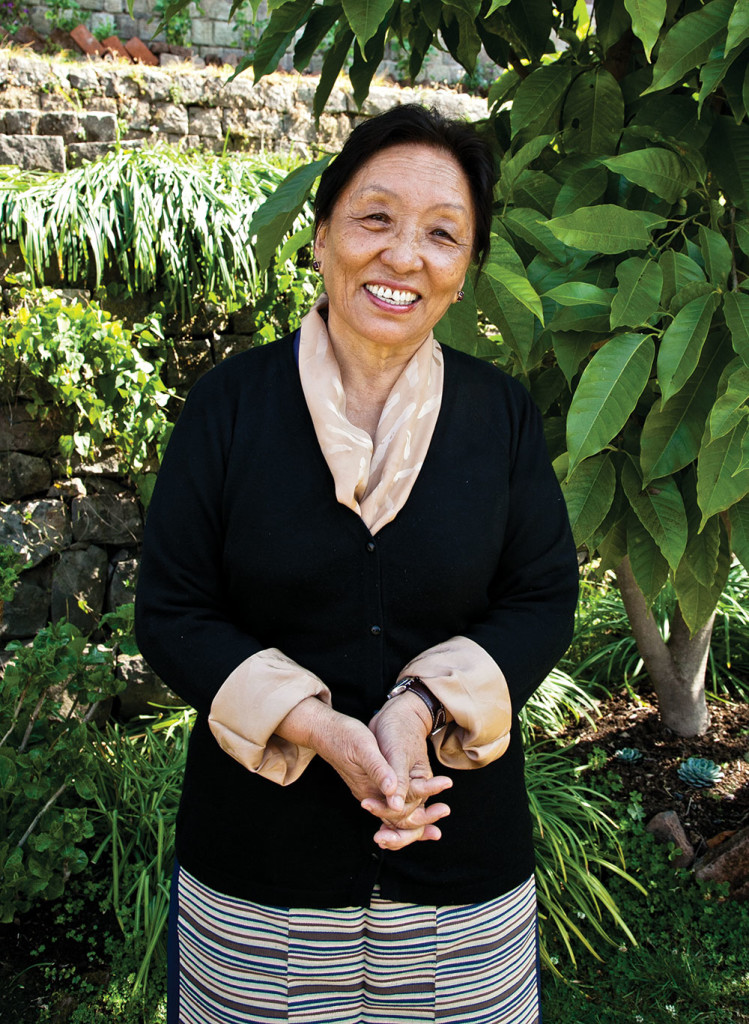
Commitment to education is crucial to the preservation of Tibetan culture. Could you talk about that, both in your own life and in that of the exile community? After 1959, my family and the other Tibetans who were in India could not go back to Tibet. In the early 1960s, the Tibetan government in exile, formerly known as the Central Tibetan Administration, started schools for the children. But when my sisters and I were young, these schools were not yet there. My family had to pay for the schools that we went to.
My mother sold the jewelry she brought with her on pilgrimage to pay for our education. She barely knew how to read, but she deeply knew the value of education. I remember her saying, “We’ll sell the jewelry and give the children education. That’s something which nobody can take away.”
It is because of the schools started by His Holiness that Tibetans in exile are Tibetans today. The Central Tibetan Administration has come a long way in terms of educating the young since those early days. They have now 76 schools and over 25,000 students, and a university for Tibetan students in India is in the process of becoming fully functional. The schools have given the Tibetans in exile their language, a sense of belonging, and a sense of identity.
This commitment to preserve Tibetan identity and culture has clearly fueled your own lifework. Yes. Like many others, I have been dedicated to my community, but first, I will tell you, woman to woman, because I had chosen to get married and have children and I felt it was my responsibility, I took care of my own family. Until my children were 9 and 10, I was totally at home for 24 hours. Also, at that time we lived with my late mother-in-law, His Holiness’s mother, and I felt that this was my time to look after her. When my mother-in-law passed away and my children grew up, I thought, “Okay, now I need to do something for the community.” While I had my secret eye around, women began to meet to reestablish the Tibetan Women’s Association.
Why do you say “reestablish”? Good that you ask this. The original Tibetan Women’s Association was actually founded in Tibet by women in my mother’s age group on the 12th of March in 1959. A courageous group of women demonstrated on the grounds below the Potala Palace in Lhasa, 15,000 of them protesting against the Chinese occupation.
After 1959, some of the women from the original Women’s Association managed to flee. They got together in Dharamsala to talk and keep that moment of protest alive. But after most of the senior members passed away, the organization gradually disappeared.
In 1984, His Holiness rallied our interest: “I remember there was once a Women’s Association. What happened?” The women in my age group said, “Now it’s time for us to wake up.” So we contacted Tibetan women from all over the world. Within a few months, with their support, we held the first general meeting of the revived Tibetan Women’s Association. His Holiness addressed us, saying, “I have great faith in women’s strength. For all of the Tibetan people, I am glad you have revived this.” He added, “You must also help the nuns.” That seed was sown in my head so strongly that it never went away.
In the mid-1980s, there were only two nunneries around Dharamsala, and maybe a few in Nepal. Those first nunneries had no proper facilities, and there was no education provided whatsoever. The newly revived Tibetan Women’s Association established a new nunnery in the south and made the commitment to provide education for the nuns.
Suddenly in late 1990, we had a great influx of nuns from Tibet. We decided to separate the Tibetan Nuns Project, a religious entity, from the Tibetan Women’s Association, a political entity. And the TNP decided to look after nuns in all the Tibetan traditions and not any one solely, whether Gelug, Sakya, Kagyu, or Nyingma.
Is this the first time that nonsectarian institutions have been established for Tibetan monastics? His Holiness had already introduced a nonsectarian institution for men in Dharamsala. But for the first time we started nonsectarian institutions in the women’s world. We are trying to bring in the goodness of the four traditions; they all go to the same ultimate goal. It would be foolish to say, “Mine is better than yours.”
Isn’t it also the first time now that higher education equivalent to that offered for monks is available to Tibetan nuns? Yes, this is new. Many institutions have now opened their programs to nuns, but none have yet granted the highest degrees. At Dolma Ling, nuns can pursue the 17-year program of philosophical studies required for a Geshema degree, the highest degree available. Courses are also offered in Tibetan language, English, mathematics, computer skills, and basic medical training, as well as in ritual arts such as sand mandalas and butter sculpture.
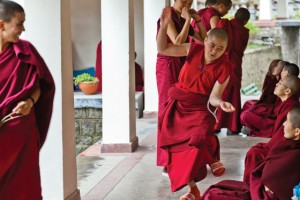
One of the most exciting new opportunities for the nuns is training in debate. Debate demands brave and rigorous practice intellectually and also physically, involving complex and dramatic gestures. Was debate culturally challenging for women initially? The nuns are training in debate for the first time in the history of Tibet. Some say that long ago there were nuns who did debating and they did so well that the men were jealous of them, so the training was stopped. Of course, this may be simply a legend. The current debate training is the first that we know of for sure. And to answer your question, yes, initially when we taught the nuns the dialectics and all the other aspects of debating, they were very timid. So we’ve had to encourage them.
The annual inter-nunnery debate, a month long with six nunneries participating, is a major source of inspiration for the nuns to seriously pursue their studies and offers them the confidence they need to become effective teachers in nunneries and schools. Over the past 18 years, the number of nuns participating has grown, and the nuns have become increasingly confident. Also, when we first started debating, the male counterparts were encouraging, but some seemed to take the attitude “Hmmm, let’s see. . .” Now they have gotten more accustomed to it!
I’m imagining that doing debate practice is very personally transformative. Yes. As you may know, the Buddha said, “My words are not to be simply accepted; they are to be tested.” So debating trains you to be clear and gives you an analytical mind. When you study Buddhism you can analyze what really makes sense rather than simply memorizing. And to daily life, you bring skills in analysis and clear thinking.
So through analytical skill the nuns gradually learn to de-construct some of the delusions that drive their lives? Exactly. As you analyze your experience, you have new understanding. For one thing, you come to realize that your “self” may not be here by this time tomorrow. Therefore, why cling so much onto that so-called self?
I tell the nuns, “Eventually, when you become a scholar, don’t just say, I am going to write a book. I am going to be famous. I am going to earn this much salary. After all, you have shaved your hair. You have chosen to wear the robe. For what? You’ve chosen not to get married, not to have children. For what? You have to always keep thinking, otherwise you could be more selfish than those of us with husbands and children. At least we have a family to look after. You don’t have anybody to think about but yourself. So if you focus on that, you could be the worst person on this planet.”
I encourage them: “Your duty is to reform yourself into a good human being, and then be an example to the rest of the world. By having had this opportunity to study, you’re not going to be selfish. You’re not going to be elaborate. You are going to be altruistic and simple.”
Some say that long ago there were nuns who did debating and they did so well that the men were jealous of them, so the training was stopped.
The retreat cottages you have recently built are an ideal place for the kind of sustained contemplation you are suggesting. Are retreat facilities for nuns also an innovation not offered in Tibet? Again, the concept is not new. Nuns also retreated in caves in Tibet many years ago. In fact, it is said that some of them were wonderful retreatants, highly realized people. But over the years, the retreat practice changed. Nuns may go on retreat for many months, but mostly they recite mantras. I want to offer them the opportunity for more than that. I say, “Recite the mantras, but understand them and make them part of yourself. Once you come out of the retreat cell, if you are the same as when you went in, then what’s the point?” His Holiness has always said that women have more ability to be compassionate than men, because we have the mother seed in us. But I think we have to really water it.
In the past, in Tibetan culture, the status of women, and of nuns in particular, has been low. Changes offering new opportunities for women might appear at first to be in conflict with the effort to preserve Tibetan tradition. Not at all. In general, in the whole exile life His Holiness has done nothing but what you describe: preserved the better part of the culture and tried to get rid of those parts which were not necessary, introducing new concepts that would be good for the people and the nation in the long run. He has worked for over 50 years to give the Tibetan people freedom and democracy, to give women education. This is introducing a new system.
Coming to the nuns, we’ve preserved the old, because there were nuns even in ancient times, from whenever there were monks. But what nuns didn’t have was their current status and education. So we have introduced that, giving them the chance to learn more for themselves from the dharma.
With these innovations in the nuns’ education, we are not changing anything in the substance of what they are learning, because you can’t change buddhadharma. In the past they were having lots of soup, but it was all broth. The soup was very delicious, but the nuns didn’t have a chance to see what the soup was made of. Now, with education, they’re getting opportunities to learn the ingredients—what the Buddha taught.
In addition to the opportunities for advanced study, for debate practice and solo retreat, you are also empowering the nuns through encouraging an ethic of increased self-sufficiency. At Dolma Ling, the nuns take responsibility for managing their institution even if they are never going to be completely self-sufficient. They take on the work of running the nunnery: sewing, papermaking, tofu-making; tending cows for milk, gardening; training in computers, cameras, and video; and for modest income, sewing and crafts, and running a guesthouse and a small café.
As we study the buddhadharma here in the midst of exile, we are making Tibet part of ourselves so we can carry the teachings wherever we serve in the world. Learning to take responsibility for our institutions is crucial in this process. We deeply appreciate the generosity of our donors, but if they take care of everything and we do nothing, a little light goes out. That would be the saddest thing. We lost our country, but we have not lost ourselves.
See more debating photos from Jeanne O’Connor:
